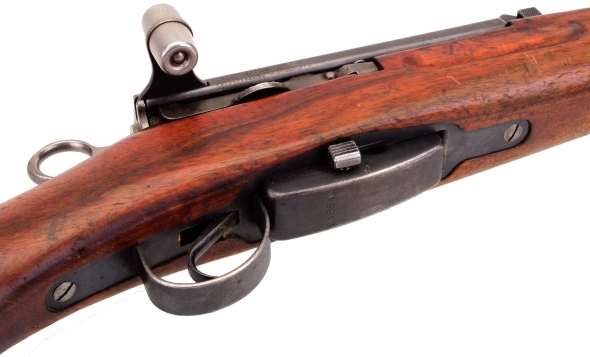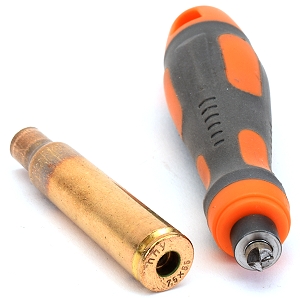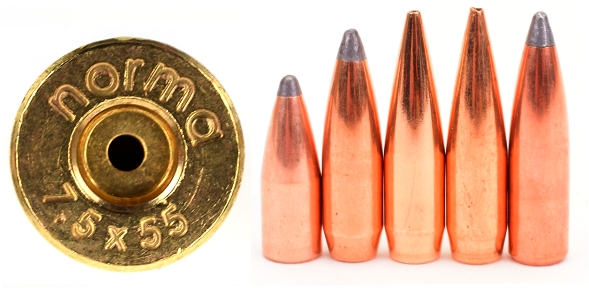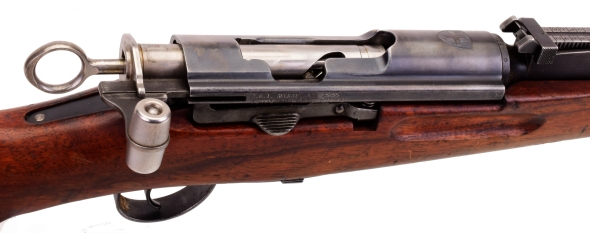
The intention was to shoot a few rounds of factory ammo to baseline accuracy, but that turned into a few boxes of factory ammo while I got a better feel for the rifle and thought about an approach to take with handloads. Recoil was light, accuracy was decent, cycling was clean. Seventy plus year old steel and walnut, worn bluing and linseed oil; what’s not to like? It’s personality is that of many old military rifles.
The K31’s Common Ball Cartridge 11 is specified in the 1958 Swiss Rifle Manual as producing 780 m/sec, approximately 2,560 fps, with a 11.3 gram bullet, approximately 174 grains. Prvi Partizan 174 grain FMJ is rated at 770 m/sec, approximately 2.526 fps, but clocked an actual 2,334 fps. Because the chronograph reading was relatively low, the velocity was double checked with a second chronograph, which yielded statistically the same results.
The 7.5x55mm in the K31 does not, or at least should not, duplicate 308 Winchester performance. While the 7x55mm cartridge does have 10 grains greater capacity than the 308 Winchester, the K31 has a maximum operating pressure of 3200 bar, approximately 46,401 psi, firearm, where 308 Winchester chambered rifles routinely handle 60,000 – 62,000 psi respectively, CIP or SAAMI standards. Subsequently, the .308 Winchester cartridge has a solid 150 – 250 fps advantage over the K31 cartridge depending on load type.
It is more than a little ironic that some folks who claim to honor Swiss technology and precision often have no problem ignoring the specifications set by the Swiss. My favorite stupid “expert” recommendation found on the Internet is “…just use 308 Winchester start data and work up from there. It is almost the same cartridge”. Setting aside the issue of incorrect powder charges and primer selection, using .308 Winchester data means starting without dimensional specifications for the assembled cartridge. Hornady, Lee, Norma, and Sierra all provide 7.5x55mm data. Ask yourself, “What would Elvis do?”
Along the way…
The goal within this project was to produce handloads that approximate the original cartridge’s performance in heavier bullet weights for hogs, black bear, deer, elk, moose, and similar and handloads of a lighter weight with higher velocity for smaller thin skinned game. I think we got there.
 Even with once fired Prvi empties to work with, a decision was made to begin with new Norma brass. Certainly not typical for Norma, case mouths were rough and irregular and primer pockets presented a significant problem. The pockets in an entire box of 50 cases measured 0.208″, the extreme minimum diameter and they had a rough sharp perimeter. CCI 200 large rifle primers measured 0.212″, just under maximum, and they would not start into the primer pocket. Cleaning up the pocket edges did not help, so Remington 9 1/2 large rifle primers that measured 0.211″ and had thinner cup walls were substituted and assembled properly.
Even with once fired Prvi empties to work with, a decision was made to begin with new Norma brass. Certainly not typical for Norma, case mouths were rough and irregular and primer pockets presented a significant problem. The pockets in an entire box of 50 cases measured 0.208″, the extreme minimum diameter and they had a rough sharp perimeter. CCI 200 large rifle primers measured 0.212″, just under maximum, and they would not start into the primer pocket. Cleaning up the pocket edges did not help, so Remington 9 1/2 large rifle primers that measured 0.211″ and had thinner cup walls were substituted and assembled properly.
In a brief Facebook exchange, someone asked why I didn’t just use a primer pocket reamer or uniformer to open the pocket. A uniformer is actually a depth cutter and it’s purpose is to set the primer pocket seat parallel to the case head. The shank of the cutter is machined to operate as a pilot. Finally, the cutter is only 0.208″ in diameter, or minimum for a large rifle primer. A primer pocket reamer is typically used to remove military crimps from primer pockets and has the same side cutting diameter limitations.

The last K31 used in a shop project had been throat reamed to clean up some pitted lands. Subsequently, it was generous in permitting a little more cartridge overall length and bullets with a more blunt ogive. This was not the case with this subject rifle with an excellent bore as verified with an OAL Gauge, modified cartridge and each planned bullets. The cartridge overall length indicated on the load data table reflects maximum length, bullet contacting rifling, minus 0.020″ safety margin. The order of bullets on the table are as they appear in the photo above, left to right.
The smokeless powder selected worked well from an accuracy and velocity standpoint, although the next time around, based on some preliminary data collection, I would drop Norma URP and Re19 and expand the use of Re17 and IMR 7828 SSC. I did try Norma 203B and 204 but the results were just OK. In fact, I would say that less then case full powder speed seemed to work the best.
 |
Warning: Bullet selections are specific, and loads are not valid with substitutions of different bullets of the same weight. Variations in bullet material and length will alter net case capacity, pressure and velocity results. Primer selection is specific and primer types are not interchangeable. These data represents maximum loads in our firearms and test equipment and may easily be excessive in other applications. All loads should be reduced by 5%, and developed following safe handloading practices as represented in established reloading manuals produced by component manufacturers. Presentation of these loads does not constitute a solicitation for their use, nor a recommendation.
|
|||||||||||||||||||||||||||||||||||||||||||||||||||||||||||||||||||||||||||||||||||||||||||||||||||||||||||||||||||||||||||||||||||||||||||||||
|
||||||||||||||||||||||||||||||||||||||||||||||||||||||||||||||||||||||||||||||||||||||||||||||||||||||||||||||||||||||||||||||||||||||||||||||||

| Source | Diameter A” |
Length B” |
Diameter C” |
| Norma Unfired | 0.490 | 1.818 | 0.454 |
| Norma Fired | 0.495 | 1.823 | 0.473 |
| Factory New | 0.495 | 1.801 | 0.455 |
| Factory fired | 0.495 | 1.820 | 0.473 |
As an added check for excessive pressure, factory ammunition was fired along side the handloads made from new Norma brass. The only exceptional dimensional change was the case body just above the extractor groove where the Norma brass grew from 0.490″ is diameter to 0.495″. However, the new Norma brass began well under the nominal spec of 0.496″. Velocity and load data is in line with mainstream reloading manuals
Fun
The K31 has a good shooting personality. It has a decent bark, slight muzzle rise and light recoil. Its heft makes it steady when shooting from the standing position and the magazine sits back far enough to keep out of the way when shooting. The rifle handles well, but the straight pull takes some adjustment as muscle memory still had me attempting to rotate the bolt open for some time. I like the small “U” notch of the tangent sights and slender front sight blade. It would be a tough set up for me to use in a woodland setting as an issue of visibility, but they are precise when poking at targets.
Accuracy was good with a scope. I could not find the super sub MOA group sizes some folks seem to find on a routine basis, but the K31 still shot much better than almost all other infantry grade bolt action rifles I’ve encountered.

Could he K31 be used for hunting? Sure and I know many people use one for just that purpose. Would I take it hunting? Probably not, as there are many rifles better suited to the task and I feel no connection to, or sense of reverence for, the K31’s history. The K31 is a complicated design, few performance pieces are available for tinkerers and it is not an easy or inexpensive firearm to modify and I can’t think of any particular asset it represents that could not be satisfied more effectively by any number of other military surplus rifles. Still, it is unique in design, interesting to work with and certainly worth some time to work up handloads and put in some range time.

Email Notification